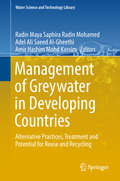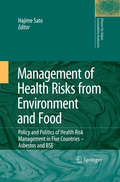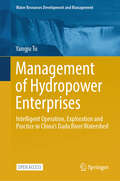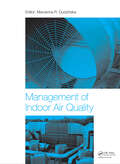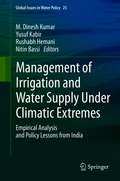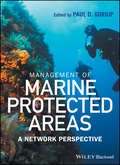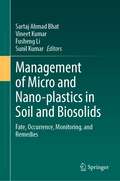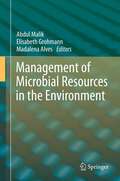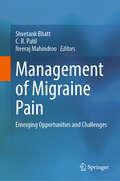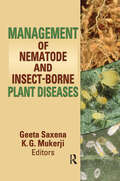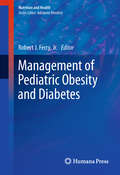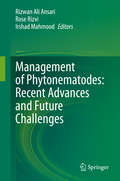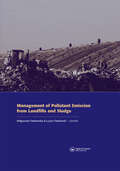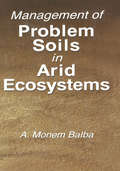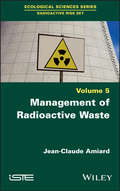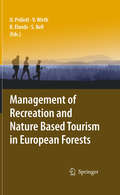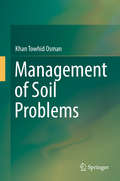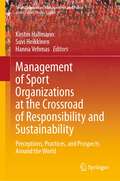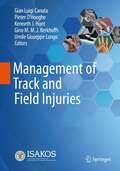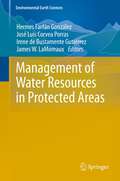- Table View
- List View
Management of Greywater in Developing Countries: Alternative Practices, Treatment And Potential For Reuse And Recycling (Water Science and Technology Library #87)
by Radin Maya Saphira Radin Mohamed Adel Ali Saeed Al-Gheethi Amir Hashim Mohd KassimThis book reviews the consequences of improper disposal of greywater into the environment and the most appropriate treatment technologies for developing countries, focusing on the potential to reuse greywater as a production medium for biomass and bio-products. It also describes the quantities and qualitative characteristics, as well as the common practice of discharging greywater in developing countries, and highlights the associated health risks. Further, it compares the management of greywater in developed and developing countries and explores the advantages and disadvantages of various treatment technologies, discussing the reuse of greywater for irrigation purposes in arid and sub-arid countries, especially in the Middle East. The book shows the benefits of greywater and introduces low-cost technologies based on the available local facilities can be used to discharge, reuse, and recycle it.
Management of Health Risks from Environment and Food
by Hajime SatoThis book examines the policy and politics of two health risks, which have recently become prominent social issues in many countries. One is the issue of asbestos as an environmental risk to humans, and another is that of bovine spongiform encephalitis (BSE), or mad cow disease as an animal disease, and of its variant Creutzfeldt-Jakob disease (CJD) as a human food risk. Employing a set of analytical frameworks in political science, each case study explores how the issues emerged, agendas got set, alternatives were chosen, and policies were implemented. Through the analysis, it is examined how safety and public reassurance were pursued in the countries studied (Japan, the UK, France the USA, and Korea). Exploration of the successes and failures in their efforts discloses the key elements to successful health risk management.
Management of Hydropower Enterprises: Intelligent Operation, Exploration and Practice in China’s Dadu River Watershed (Water Resources Development and Management)
by Yangju TuThis open access book highlights the hydropower potential of the Dadu River watershed in Sichuan province, Southwest China, and an important part of the flood control system for the Changjiang (Yangtze) River. Ensuring the safe, scientific, and economical operation of hydropower stations is the basis for sustainable development for hydropower enterprises and is the foremost task during the process of running and managing hydropower enterprises. Because of the special natural, geographical, and cultural environment in the Dadu River watershed, the operation and management of hydropower enterprises face numerous challenges due to complex hydrometeorology, frequent earthquakes and geological hazards, fragile ecological environment, and difficult conditions for production. In order to effectively resolve the many challenges on the Dadu River in terms of reservoir group operational control, power station group power dispatch, operation and inspection of equipment for the whole watershed, operation of multiple power station hydraulic structures, and watershed enterprise management, the multiple power stations in the Dadu River watershed adhere to the concept of innovative development and actively embrace advanced technologies such as cloud computing, big data, Internet of Things (IoT), and artificial intelligence. In 2014, the Dadu River Company was the first in the corporate world to put forward the dream and approach for the construction of the intelligent enterprise, while boldly carrying out exploration and practice in intelligent operations and management in the Dadu River watershed.
Management of Indoor Air Quality
by Marzenna R. DudzińskaDue to changes in lifestyle, people spend more time indoors. This refers not only to the time spent at home and at office premises, but also in shopping malls, recreation centers and transport vehicles. Concentrations of many pollutants are higher indoors than they are outdoors. Consequently, the indoor environment has a bigger impact on human heal
Management of Irrigation and Water Supply Under Climatic Extremes: Empirical Analysis and Policy Lessons from India (Global Issues in Water Policy #25)
by M. Dinesh Kumar Nitin Bassi Yusuf Kabir Rushabh HemaniThis volume provides a theoretical basis for the argument that available research that analyzes the impacts of climate on hydrology, water resources, and water systems, without factoring in the effect of climate variability, are inadequate and often misleading. Also, the book empirically shows that the impacts of climate variability on hydrology and water resources, and irrigation, water supply & sanitation systems are far more pronounced than the likely impacts of future change in climate. The book discusses technological, institutional and policy alternatives for reducing these impacts on various competitive use sectors, especially, irrigation, and water supply and sanitation through case studies of river basins in different hydrological setting.To set the context, the volume first presents the long term trends in precipitation and temperature in different regions of India, and compares them against inter-annual, inter-seasonal and intra-day variations in climatic parameters, to show how their differential impacts on water resources.
Management of Marine Protected Areas: A Network Perspective
by Paul D. GoriupWith the health of the world’s oceans threatened as never before, it is becoming increasingly apparent that Marine Protected Areas (MPAs) play a vitally important role in protecting marine and coastal habitats. Management of Marine Protected Areas: A Network Perspective draws on the results of a major EU-sponsored research project related to the establishment of networks of MPAs in the Mediterranean and Black Seas that transpired from February 2011 to January 2016. Featuring contributions by leading university- and national research institute-based scientists, chapters utilize the latest research data and developments in marine conservation policy to explore issues related to ways in which networks of MPAs may amplify the effectiveness and conservation benefits of individual areas within them. Topics addressed include the broader socio-economic impacts of MPAs in the Mediterranean and Black Seas; the use of Marine Spatial Planning (MSP) to resolve conflicts between marine resource use and protection; special protection measures under the EU’s Marine Strategy Framework Directive (MSFD); ecological value assessments in the Black Sea; the Ecosystem Approach (EA) for managing marine ecosystems; MPAs along Turkey’s Black Sea coast; MPAs and offshore wind farms; and managing and monitoring MPA networks within and between the Black and Mediterranean Seas. Timely and important, Management of Marine Protected Areas: A Network Perspective offers invaluable insights into the role of MPAs in preserving the welfare and long-term viability of our world’s oceans.
Management of Micro and Nano-plastics in Soil and Biosolids: Fate, Occurrence, Monitoring, and Remedies
by Sunil Kumar Vineet Kumar Sartaj Ahmad Bhat Fusheng LiThis book comprehensively assesses the management of micro and nano-plastics in contaminated soil and biosolids, highlighting recent techniques and technologies that facilitate their environmental remediation. It provides up-to-date information on the fate, occurrence, monitoring, and transport of micro and nano-plastics in the environment, aiming to determine their detrimental impact on environmental health. The book also explores how risk factors associated with these particles can be identified and mitigated through sustainable means. Micro and nano-plastic contamination is analyzed in various contexts, including agricultural soil systems, urban areas, and wastewater. Special attention is given to the mechanisms of recent decontamination strategies, such as microbial and enzyme-assisted degradation and biochar. The intended audience for this book includes students, researchers, professionals in the urban municipal wastewater treatment sector, waste management and industrial practitioners, as well as policymakers.
Management of Microbial Resources in the Environment
by Madalena Alves Elisabeth Grohmann Abdul MalikThis volume details the exploration, collection, characterization, evaluation and conservation of microbes for sustainable utilization in the development of the global as well as national economies, e.g. in agriculture, ecosystems, environments, industry and medicine. Many research institutes and universities all over the world carry out microbiological and biotechnological research, which generates substantial genomic resources such as cDNA libraries, gene constructs, promoter regions, transgenes and more valuable assets for gene discovery and transgenic product development. This work provides up-to-date information on the management of microbial resources in the environment. It also covers the ecology of microorganisms in natural and engineered environments. In trying to understand microbial interactions it further focuses on genomic, metagenomic and molecular advances, as well as on microbial diversity and phylogeny; ecological studies of human, animal and plant microbiology and disease; microbial processes and interactions in the environment; and key technological advances. Though not intended to serve as an encyclopedic review of the subject, the various chapters investigate both theoretical and practical aspects and provide essential basic information for future research to support continued development.
Management of Migraine Pain: Emerging Opportunities and Challenges
by Shvetank Bhatt C. R. Patil Neeraj MahindrooThe book delves into the multifaceted world of migraine pain, offering a profound understanding of its underlying pathophysiology and presenting established treatment strategies for its effective management. It discusses the intricate world of migraine pain, offering valuable insights into its diverse aspects. Starting with an exploration of migraine's epidemiology and etiology and the complex factors contributing to this debilitating headache disorder. This book explores the significance of lifestyle changes and offers practical strategies for incorporation. Furthermore, the impact of diet and nutrients on migraine management is extensively covered, shedding light on their role in alleviating symptoms. This book serves as a comprehensive guide, blending scientific insights with practical approaches, making it an indispensable resource for healthcare professionals, researchers, and individuals seeking a deeper understanding of migraine pain. By addressing both established practices and cutting-edge advancements, it bridges the gap between knowledge and effective management, offering a holistic perspective on this challenging condition.
Management of Nematode and Insect-Borne Diseases
by K. G. Mukerji Geeta SaxenaA comprehensive resource for students and researchers Management of Nematode and Insect-Borne Plant Diseases examines the various aspects of disease control from an international perspective. Leading academics and researchers around the world address the microbial control of insect pests, the use of nematophagous fungi and biofumigation in the control of plant-parasitic nematodes, the use of genetically manipulated microbes, and the biology and control of vectors. Management of Nematode and Insect-Borne Plant Diseases provides detailed descriptions of the management of diseases caused by insects and by plant-parasitic nematodes. This unique book includes in-depth examinations of the use of arthropod microbial control agents; the biology and control of bacteria; the use of living and synthetic mulches; the genetic transformation of microbial control agents; the integrated use of different control options; the use of nematophagus fungi as a control agent; the use of biofumigation; potato early dying complex; host/plant resistance; and RNAi silencing. Each chapter is written by an experienced scientist in that specific field to produce a single reference resource. Management of Nematode and Insect-Borne Plant Diseases includes: the latest research on the development of microbial control agents against insect and mite pests up-to-date theory on the management of the vectors and disease in fruit and nut crops the use of mulches in the control of homopteran pests an overview of the microbial control of insect pests a look at the increasing role of biological control agents an examination of nematode resistance in vegetable crops a historical background of RNAi, its biology, and its function in the eukaryotic system and much more Management of Nematode and Insect-Borne Plant Diseases is a comprehensive professional resource for botanists, agriculturalists, environmental scientists, biologists, zoologists, ecologists, entomologists, plant pathologists, horticulturalists, plant protection scientists, and biotechnologists.
Management of Pediatric Obesity and Diabetes
by Robert J. Ferry Jr.The twin epidemics of obesity and type 2 diabetes mellitus (T2DM) continue to affect an ever increasing number of children, adolescents, and young adults. Management of Pediatric Obesity and Diabetes provides healthcare trainees and professionals with practical, comprehensive, and contemporary approaches to the pediatric patient at risk for obesity, T2DM, and related conditions. A unique guide on the subject, this volume provides clinical paradigms for diagnosis and management of pediatric T2DM and related conditions, while succinctly describing state-of-the-art basic and clinical sciences underlying these problems. The chapters in this volume are independent and concise. Each chapter focuses on a key clinical issue or mechanism of disease. Providing practical, data-driven resources based upon the totality of the evidence, this important text helps the reader understand the basics of pediatric obesity and T2DM and implement strategies to prevent and treat obesity and diabetes in children and adolescents. Management of Pediatric Obesity and Diabetes provides health professionals across many areas of research and practice with up-to-date, well-referenced, and comprehensive evidence on identification, treatment, and prevention of these chronic, serious, metabolic diseases in children. This volume will serve the reader as the most authoritative resource in the field to date.
Management of Phytonematodes: Recent Advances and Future Challenges
by Rizwan Ali Ansari Irshad Mahmood Rose RizviThis book illustrates the currently available strategies for managing phytonematodes. It discusses the latest findings on plant-pathogen-microbiome interactions and their impacts on ecosystems, and provides extensive information on the application of microorganisms in the sustainable management of phytonematodes. This is followed by an in-depth discussion of the application of potential strains of biocontrol fungi, endophytes and actinomycetes to enhance plants’ ability to fend off phytonematode attacks, leading to improved plant health. In conclusion, the book addresses new aspects like the biofabrication of nanoparticles and their application in plant disease management, and presents an extensive list for further reading.
Management of Pollutant Emission from Landfills and Sludge
by Malgorzata Pawlowska Lucjan PawlowskiThis book reviews of recent findings on the mitigation of gas emission from landfills and sludge processing. It covers methane and the migration of POPs, heavy metal ions, ammonia and nitrate from landfills to the water-soil system and to the atmosphere. It also discusses strategies for mitigating the impact of pollution on ecosystems. The book contains a selection of papers presented at an International Workshop on Management of Pollutant Emission from Landfills and Sludge, Kazimierz Dolny, Poland. Topics include mitigation of gas emission from landfills, pathway of POPs in waste, wastewater and landfill leachate, and migration of heavy metals from waste disposal sites and sewage sludge.
Management of Problem Soils in Arid Ecosystems
by A. Monem BalbaManagement of Problem Soils in Arid Ecosystems examines the challenges of managing soils in arid and semiarid regions. These soils contain low organic matter, are not leached, and accumulate lime, gypsum, and/or soluble salts, requiring special management and practices. This book discusses how to identify problems, reclaim the soils, and then use them efficiently and economically. Water management and desertification in these areas are also discussed. It contains extensive references as well as 40 tables and illustrations.
Management of Radioactive Waste
by Jean-Claude AmiardThe classification of radioactive waste varies from state to state. This results in different management procedures for each country, while following IAEA and OECD/NEA recommendations.Radioactive waste comes from numerous sources. The largest volumes are generated by the decommissioning and dismantling of nuclear facilities. Long-lived, medium- and high-activity waste – categorized as the most hazardous types of waste – are in fact largely produced by nuclear power reactors, spent fuel reprocessing plants and nuclear accidents.Final disposal of very low-activity, low-activity and very short-lived waste is well controlled. However, final solutions for certain categories, including long-lived waste, sorted waste and spent graphite waste, are not yet in place.Management of Radioactive Waste reviews all the possible solutions and presents those chosen by the various states, including a chapter detailing policy on radioactive waste management, taking France as an example.
Management of Recreation and Nature Based Tourism in European Forests
by Simon Bell Ulrike Pröbstl Birgit H. Elands Veronika WirthThis book provides for the first time a Europe-wide overview on the state of the art of management of recreation and nature tourism in forests. It describes the current situation and conflicts in the different regions of Europe and provides solutions illustrated by good practise examples. It addresses traditions, differences and similarities in European forests as well as new tasks, goals and strategies. The final discussion provides a profound insight into future trends regarding forest recreation and nature based tourism.
Management of Severe Traumatic Brain Injury: Evidence, Tricks, and Pitfalls
by Per-Olof Grände Terje Sundstrøm Teemu Luoto Christina Rosenlund Johan Undén Knut Gustav WesterThis comprehensively updated second edition features major revisions, 24 new chapters and more than 40 new authors, reflecting both the advances and key challenges within the field. Offering a systematic guide to the management of children and adults with severe traumatic brain injury throughout the entire chain of care, it includes evidence-based recommendations for each diagnostic and therapeutic measure, together with tips, tricks and pitfalls. The authors are all highly experienced clinicians and researchers who work with neurotrauma patients on a daily basis, and the editors represent the Scandinavian Neurotrauma Committee.The book helps professionals provide more systematic and higher-quality care in prehospital settings, primary hospitals, neurosurgical departments, neurointensive care units, and rehabilitation facilities. It is intended for all healthcare personnel involved in the multidisciplinary management of patients with head injuries, especially those in emergency care, neurosurgery, anesthesiology, radiology, and rehabilitation.
Management of Soil Problems
by Khan Towhid OsmanSoils are neither good nor bad, but some have inherent or acquired characteristics that may or may not suit our intended use. Unsuitable characteristics are considered to be soil problems, soil constraints or soil limitations. Only twelve percent of global land is right for agricultural production without much limitation. Some soils have severe limitations for crop production. These soils are so called ‘problem soils’. Many of them do not have enough fertility to be productive; some are arid and saline; some are very sandy and dry; and some are wet and waterlogged for most of the growing season. The global demand for food, wood, fuel, fiber, medicine and other plant products for the 7.2 billion current world population has created such an immense pressure on global soil resources that even the most fertile soils are losing their productive capacity. We are being compelled to bring more and more unsuitable or marginally suitable soils under cultivation. Unless innovative and integrated soil, crop and environmental management practices are adopted for their improvement and sustainable use, further degradation is inevitable. This book, Management of Soil Problems, identifies the problems and discusses management options in a smooth and reader-friendly style. It will be useful for students and professionals of soil science, agriculture, forestry, geography and environmental sciences.
Management of Sport Organizations at the Crossroad of Responsibility and Sustainability: Perceptions, Practices, and Prospects Around the World (Sports Economics, Management and Policy #25)
by Kirstin Hallmann Hanna Vehmas Suvi HeikkinenThis edited volume evaluates how sport organizations in the public, private, and non-profit sectors define responsible management and sustainability and what these mean in their daily operations. Using country-specific cases, the chapters provide an empirical investigation of sport organizations in each sector, analyzing managerial decisions and policies through a sustainability lens. All chapters are structured in the same way, providing a truly comparative approach. Offering insights for scholars interested in responsibility and sustainability in different context, this volume will be important to undergraduate and postgraduate sport management, event management, sport science, and sport study programs around the globe.
Management of Track and Field Injures
by Gian Luigi Canata Gino M. M. J. Kerkhoffs Kenneth J. Hunt Pieter D’Hooghe Umile Giuseppe LongoThis volume offers a comprehensive guide to the prevention, management of injury, risk factor mitigation, and rehabilitation in track and field athletes. It serves as a valuable resource for the sports medicine community, including surgeons, sports medicine physicians, physical therapists, and athletic trainers.In addition to addressing current management techniques for injuries, the book discusses various special considerations, e.g. biologics, the aging athlete, rehabilitation, nutrition, and gender.Published in collaboration with ISAKOS, this book offers an updated information authored by experts in the field, and a valuable contribution to the field of orthopedics and sports medicine.
Management of Waste to Control Environmental Pollutions: Sustainability and Economic Feasibility (Sustainable Landscape Planning and Natural Resources Management)
by Javid Ahmad Parray A. K. Haghi Nowsheen ShameemThis book analyzes the harmful effects of conventional waste treatments and pollution monitoring methods on the environment. It critically evaluates these methods and highlights their shortcomings that have significantly damaged the environment. The book provides a comprehensive overview of alternative waste and pollution treatment methods that can be adopted locally and internationally. It also examines appropriate resource management strategies for environmental issues and emphasizes the need for sustainable resource management practices. The book highlights the importance of education in achieving ecological sustainability, particularly in urban waste management. It elaborates on how education can raise awareness and promote sustainable waste management practices. Furthermore, the book presents the latest research topics, innovative ideas, and remediation strategies for various hazardous pollutants related to environmental issues and solutions. It provides a detailed analysis of the different remediation strategies and highlights their effectiveness in tackling environmental issues. The book also explores the innovative use of nanotechnology to achieve ecological sustainability and economic feasibility in wastewater treatment. One of the standout features of this approach is the use of microbial consortiums, which offer significant advantages over pure cultures. The need for hybrid treatment technology to effectively remediate different types of organic and inorganic pollutants from wastewater is also explored. In addition, the book highlights the application of green technology for waste management, providing innovative solutions using advanced green technologies that promote international cooperation and networking to achieve a sustainable environment. It covers advanced green technologies used to manage energy and bioproducts from waste, such as biofuel, biopolymers, fertilizers, and chemicals, without causing harm to the environment.
Management of Water Quality in Moldova
by Gheorghe DucaThis book deals with water management, one of the most challenging issues of contemporary society. Research and innovation in the field of water management must address certain fundamental aspects: access to water, water quality, water treatment, transboundary effect of water, etc. A comprehensive analysis was performed in a national research program of Moldova, entitled "Research and management of water quality". The main goal of the research program was to create and improve the legal, scientific and methodological, technological basis and sustainable development of water, implementation of modern technologies in water supply, treatment and reuse. Other priorities include expansion of access to water sources, improvement of environmental protection, especially water protection against pollution and depletion, efficient water use and establishing an effective monitoring system for disaster prevention. The topics concern research of water structure and quality, surface water, groundwater, water treatment, irrigation technologies and water pollution by remains from industry, one of the main environmental problems of our time. The book helps to get to coherent water policies of states.
Management of Water Resources Using Electrochemical Methods (Environmental Assessment and Management)
by Yong Jiang Guoshuai Liu Changyong ZhangThis book encompasses various approaches to electrochemical water treatment, emphasizing a well-structured framework within the nexus of electrochemistry, water, and energy. It addresses the urgent challenges of water scarcity and pollution and offers practical insights and operational guidance on removing pollutants and preserving water resources through water purification. Applications and real-life case studies support the innovative nature of electrochemical processes as a sustainable and efficient alternative. The user-friendly approach makes this book accessible to a broad audience, being a specialist seeking advanced techniques or a concerned citizen.Features Covers comprehensively the most recent and advanced electrochemical water treatment techniques. Presents practical operational guidelines and insights. Includes real-world examples and case studies. Focuses on environmental impacts and sustainability. Addresses innovative approaches in technology, theoretical computational analysis, and future development guidance for electrochemical water treatment. This book is for professionals, students, and researchers in water and environmental sciences interested in water treatment, management, and resource recovery. It is also a great resource for public and environmental health experts and readers who work in related disciplines and readers interested in water management, treatment, and the health of the environment.
Management of Water Resources in Poland (Springer Water)
by Martina Zeleňáková Abdelazim M. Negm Katarzyna Kubiak-WójcickaThis book contains a rich resource of essential information on the water resources capacities in Poland. This book contributes to the recognition of water resources management including extreme hydrological events such as floods and droughts. The book incorporates case studies illustrating solutions of water quantity management in Poland. This edited book covers all water bodies in the country including rivers, lakes, reservoirs and groundwater. The novelty of this book is that it represents the first time a manuscript covers the assessment of water resources in Poland, including variability, availability and economic use of the hydrological resources in the country with the lowest renewable resources of surface water per inhabitant in Europe. Given the depth and breadth of its coverage, the book offers engineers, researchers, policy planners, decision makers, and stakeholders essential new insights into efficient water resources management.
Management of Water Resources in Protected Areas
by James W. Lamoreaux Hermes Farfán González Irene de Bustamente Gutiérrez José Luis Corvea PorrasNatural ecosystems are heavily dependent on water, as it is essential to the development of life. The ecology and landscape play an important role in the quality and availability of water. It is no coincidence that exceptional hydrological phenomena are found in protected areas. Such is the case with, for example, the geothermic occurrences (principally, geysers) in America's Yellowstone National Park , the oldest park in the world. The Ramsar wetlands (where the ecosystem's dependency on water is strongly evident), The Iguaçu Falls (on the border of Argentina and Brazil), or the Zapata Swamp (the largest of its kind on the Caribbean island of Cuba) further exemplify this point. However, in many cases, the conservation strategies for hydraulic resources in protected areas are ignored, or simply deprived of the attention they require. There are many types of suitable management strategies for planning and protecting our valuable treasures. Hydraulic resource management in protected areas is something that must not be separated from these conservation measures. The first Symposium for the Management of Hydraulic Resources in Protected Areas was intended to be a framework of communication about experiences with water resource management in protected areas. Advances in research and possible solutions to the problems within these areas were discussed. The contributions in this proceedings volume are grouped under seven main themes: Purification and reuse of wastewater in rural communities; Impact of public use on water resources; Vulnerability and risks associated with aquifers, Design and management water resources in protected areas; Research and monitoring of water resources in protected areas; Water and its importance as a source of renewable energy in protected spaces; and Geodiversity and conservation of areas with hydraulic heritage.
